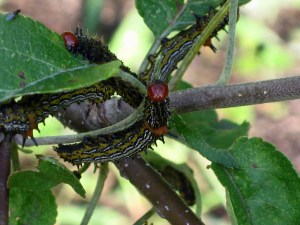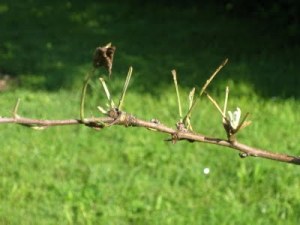Last updated on May 7th, 2012
 TRUE, there were only ten apples on my ‘Gala’ apple tree, but I had grand plans for them. “I’ll bake a pie!” was one thought. “I’ll give them away to friends!” was another. But this morning I learned that my fruit-fantasy was in vain. Why? Because a colony of very lovely but very destructive caterpillars got to my apples first.
TRUE, there were only ten apples on my ‘Gala’ apple tree, but I had grand plans for them. “I’ll bake a pie!” was one thought. “I’ll give them away to friends!” was another. But this morning I learned that my fruit-fantasy was in vain. Why? Because a colony of very lovely but very destructive caterpillars got to my apples first.
Like most modern apple tree varieties, ‘Gala’ is disease resistant. In fact, the nurseryman assured me that it would require no spraying. But he neglected to inform me of the red-humped (and headed) caterpillar, Schizura concinne, which has skeletonized every leaf of my tree, and deposited some sort of goo on the apples.

I blame the loss of my meager crop on my own lack of attention. Had I noticed the very first skeletonized leaf, I could have sprayed the tree with Bacillus thuringiensis, or “BT.” BT is a natural bacterial preparation that causes a disease-like condition in red-humped caterpillars. They stop eating several hours after feeding on a sprayed leaf and die a day or two later. I find BT completely acceptable for green-gardening; unlike the more toxic, broad-spectrum insecticides, it does not harm beneficial insects.
I expect my tree to survive this summer’s defoliation. But I’ll be more watchful next year, and have an economy-sized bottle of BT on hand.
And that is today’s woeful tale from A Garden for the House. I hope your apples are safe and sound, and free of the Red-Humped Monster.
Don’t miss anything at A Garden for the House…sign up for Kevin’s weekly newsletter.

Andrew Thompson says
You have my sympathy, Kevin. My apple tree is five years old, and I have never had a single fruit from it.
Gardenlady says
Kevin, I'm glad that your tree will survive. I gave up on fruit trees because they are all so prone to pests!
janet says
You are right, Kevin, that photograph is beautiful, but scary!
Katreader says
I'm so sorry. My apple tree has issues too. This is its second year and it's laden with fruit-but the apples look all “buggy” and those blasted Japanese beetles are eating the leaves. I did spray with an all purpose fruit tree spray earlier in the year, perhaps not early enough.
Kevin Lee Jacobs says
Janet – that photo, shall we say, was taken at “the height of the caterpillars' career.”
Katreader – How often did you spray? I was told that the all-purpose formula must be applied every two weeks – what a job!
Samantha says
I've heard so many horror stories from neighbors who have apple trees, that I have no interest in growing them myself. Thankfully, there's a large, organic apple orchard within 15 minutes of my house.
Katreader says
I only sprayed once…and they were already a bit buggy looking. Perhaps next year I'll spray as soon as the blooms disappear and be more vigilant.
Sandra Lee Robertson says
Great info Kevin…, Where do I purchase BT?
Kevin Lee Jacobs says
Sandra – Probably you can find BT at almost any farm-store. I bought mine at a place called Agway.
Diane W. says
I have a peach tree that looks like it has scabs on the leaves and fruit. What is this?
Kevin Lee Jacobs says
Diane W. – Your tree might be suffering from peach tree leaf curl. You can read more about this fungus and its treatments here.
Janet Carpenter says
Hello….could you tell me. Can I make BT or do I have to buy it?
Thank you for a reply
Kevin Lee Jacobs says
Hi Janet – You’ll have to purchased BT. It’s available at most garden centers, and definitely at farm-stores (like Agway).
Shirley L. says
Hi Kevin,
Just found your website and is learning a lot on curing my onions. How do I prevent those moths/butterflies from laying eggs in my apples. This year, out of every 10 apples, only 1 is edible.
Gary A. says
What is the adult form. Is it a moth or butterfly? I picked off about 12 or 15 and gave them to my chickens. I think I got them all.